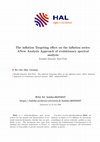Papers by ESSAHBI Essaadi

Cette these analyse la faisabilite d'une union monetaire en Asie de l'Est dans une vision... more Cette these analyse la faisabilite d'une union monetaire en Asie de l'Est dans une vision dynamique et utilise les outils appropries qui correspondent a l'histoire de l'economie regionale de la region. A partir de la litterature de la ZMO, nous testons quatre criteres ou chaqu'un d'eux sera traiter dans un chapitre. Dans le premier chapitre, nous presentons un fait stylise pour differents arrangements financiers regionaux. Suite a la litterature existence, nous testons la dynamique de l'integration financiere par le biais de l'interdependance des marches boursiers. Le deuxieme chapitre presente des perspectives a long terme des taux de change en Asie de l'Est avec une recommandation de la politique de ciblage d'inflation comme une politique monetaire regionale. L'adoption de cette politique assure un equilibre interne et maintient la stabilite de la competitivite par la stabilite du taux de change. Nous etudions la synchronisation des cycl...

Macroeconomics: Monetary & Fiscal Policies eJournal, 2017
This paper study the feasibility of a monetary union among Gulf Cooperation Council (GCC) countri... more This paper study the feasibility of a monetary union among Gulf Cooperation Council (GCC) countries, by measuring the evolution of economic integration among them. Considering the critical role of crisis and shocks in the integration process within the region, we determine whether GCC countries are characterised by a common business cycle. We suggest a different empirical approach that, unlike previous studies, allows one to endogenously detect structural changes in the comovement process between outputs. We apply a new measure for this region that is based on the time‐varying coherence function. Such a measure not only detects comovement dynamics but also distinguishes these dynamics in terms of short‐ and long‐term cycles. Additionally, we can test whether certain countries tend to be more synchronised. The main finding of this study is that not all GCC countries share a common short‐term business cycle. However, in the long term, all country‐pairs in...

In this work, we study the inflation targeting effect on the inflation dynamics in the case of fo... more In this work, we study the inflation targeting effect on the inflation dynamics in the case of four industrial countries. Our objective is to check whether the inflation targeting policy (ITP) has a significant impact on the change of the inflation path. We use a non-parametric approach that doesn't require any previous modelling. This is the evolutionary spectral analysis, as defined by Priestley (1965-1996). Then, we use a test that can detect many break points on the time series. This test is inspired by Subba Rao (1981). We use an extension to this test to allow the detection of multiple breaks. We base this on the extension of Ahamada and Boutahar (2002). This is the first time that this method is used in the case of inflation-targeting countries. We find that the inflation-targeting policy had a transition period for countries that had a high and volatile inflation experience before the inflation-targeting adoption. There is the case of New Zealand, Canada and Sweden. In these countries, we identify a structural change in the inflation series resulting to the inflation targeting intervention. However, In the case of other countries like United Kingdom that have a relatively lower inflation rate experience before the ITP adoption, we didn't find a break point caused by this monetary policy intervention. In this case, the ITP had a role of ensuring this price stability. This result is explained by the fact that the inflation targeting is relevant when the initial inflation to be stabilized is near the target range (Artus, 2004). So, in this paper we justify the intuition of Artus (2004). The second result in our paper consists on the nature of inflation stabilization during the inflation-targeting period. The results proof a long-term stabilization on the inflation dynamic in the period of IT. These results traduce the success of this new framework to anchor the inflation expectation anchoring. So, we can conclude that this policy is preferment to ensure price stability in the case of industrials countries.

Computational Economics, 2021
In this paper, we contribute to the old debate on the dynamic correlation between gold and stock ... more In this paper, we contribute to the old debate on the dynamic correlation between gold and stock markets by considering a spectral approach within the framework of portfolio hedging. Specifically, we consider eight MENA stock markets (Tunisia, Egypt, Morocco, Jordan, UAE, Saudi Arabia, Qatar, and Oman) and examine the optimal composition between gold and the stock market index, with a minimum portfolio risk and a high expected return. Based on the spectral approach, we propose seven portfolio structures and evaluate them through a comparison with the conventional DCC-GARCH method and the most best 10 portfolios constructed by using wavelet approach. The main results show that the spectral-based approach outperforms the DCC-GARCH and the wavelet methods. In fact, the optimal gold-stock composition depends on the spectral density of each stock market index, where a stock market index with a stable spectral density requires more investments in gold than a stock market index with an uns...
Energy Studies Review, 2020
This paper studies the macroeconomic effects of oil price shocks in a selection of MENA countries... more This paper studies the macroeconomic effects of oil price shocks in a selection of MENA countries. The oil price shock is identified by assuming that an individual country's performance does not affect world oil prices. We put particular emphasis on the time-varying relationship between oil prices and macroeconomic variables and implement their approach in a Time-Varying Structural VAR model (TV-SVAR) framework. The main findings are that the macroeconomic effects of oil price shocks have evolved over time in MENA countries. Interestingly, however, we do not find a lot of heterogeneity among the MENA countries they consider, even though their list includes both net oil exporters (Algeria, Bahrain, Iran, Kuwait, Saudia Arabia) and net oil importers (Turkey and Tunisia)
International Journal of Economics and Business Research, 2022

In this work, we study the inflation targeting effect on the inflation dynamics in the case of fo... more In this work, we study the inflation targeting effect on the inflation dynamics in the case of four industrial countries. Our objective is to check whether the inflation targeting policy (ITP) has a significant impact on the change of the inflation path. We use a non-parametric approach that doesn’t require any previous modelling. This is the evolutionary spectral analysis, as defined by Priestley (1965-1996). Then, we use a test that can detect many break points on the time series. This test is inspired by Subba Rao (1981). We use an extension to this test to allow the detection of multiple breaks. We base this on the extension of Ahamada and Boutahar (2002). This is the first time that this method is used in the case of inflation-targeting countries. We find that the inflation-targeting policy had a transition period for countries that had a high and volatile inflation experience before the inflation-targeting adoption. There is the case of New Zealand, Canada and Sweden. In these...

In this paper, we study the inflation dynamics in an industrial inflation-targeting country (New ... more In this paper, we study the inflation dynamics in an industrial inflation-targeting country (New Zealand). Our objective is to check if the inflation targeting policy has a transition period or not. Loosely speaking, we try to give some response to the famous debate: if the inflation targeting is a framework or a simple monetary rule. For this purpose, we use a frequency approach: Evolutionary Spectral Analysis, as defined by Priestley (1965-1996). Then, we detect endogenously a structural break point in inflation series, by applying a non-parametric test. This is the first time that this method is used in the case of inflation-targeting countries. Our main finding is that the adoption of the inflation-targeting policy in New Zealand was characterized by a transition period before the adoption of this framework. This period was characterized by many radical reforms, which caused a structural break in the New Zealand inflation series. These reforms were made to lead back the inflatio...
In this paper, we study the inflation dynamics in an industrial inflation-targeting country (New ... more In this paper, we study the inflation dynamics in an industrial inflation-targeting country (New Zealand). Our objective is to check if the inflation targeting policy has a transition period or not. Loosely speaking, we try to give some response to the famous debate: if the inflation targeting is a framework or a simple monetary rule. For this purpose, we use

The main of this paper is to check whether the inflation targeting policy (ITP) had a significant... more The main of this paper is to check whether the inflation targeting policy (ITP) had a significant impact on the change of the inflation path for four industrial inflation-targeting countries. We use the evolutionary spectral analysis, as defined by Priestley (1965- 1996). Then, we use a test that can detect many break points on the time series. We show the existence of a common consensus that monetary policy should target price stability as its primary goal through the identification of common break in 3rd quarter 1988. This break is the result of the disinflationary environment made by these countries to prepare the implementation of the ITP. Secondly, we identified two types of countries according to the manner to make this disinflationary environment. Some of them, like New Zealand Canada and Sweden, prepare an environment to implement the inflation targeting policy and made some action to raise credibility and transparency of the policies-makers. The other kinds, such the United...
Economics Bulletin, 2008
In this paper, we test the instability of comovement, in time and frequency domain, for the GDP g... more In this paper, we test the instability of comovement, in time and frequency domain, for the GDP growth rate of the US and the UK. We use the frequency approach, which is based on evolutionary spectral analysis (Priestley, 1965-1996). The graphical analysis of the Time-Varying Coherence Function (TVCF) reports the existence of variability in correlation between the two series. Our goal is to estimate first the TVCF of the two series, then to test stability in both the cross-spectra density and in TVCF by detecting various breakpoints in each function.

Economic Modelling, 2011
This paper analyzes the feasibility of a monetary union in East Asia focusing on business cycles ... more This paper analyzes the feasibility of a monetary union in East Asia focusing on business cycles synchronization. Considering the critical role of trade integration in the East Asian integration process, we study whether East Asian countries are characterized by business cycle synchronization. The related empirical literature dedicated to business cycles synchronization in East Asia does not lead to firm conclusion. In this paper, we suggest a different empirical approach allowing, contrary to the previous studies, to detect endogenously structural changes in the comovement process between outputs. We apply a new measure based on the time-varying coherence function. Such a measure not only detects comovement dynamics but it distinguishes also this dynamics between short-and long-term. We compute also cohesion statistics to test if countries tend to be more synchronized or not. The main finding of this paper is that the increase in bilateral trade inside the East Asian region significantly improves long-run business cycle synchronization. The short-run influence of bilateral trade shows mixed results. Indeed, short-run cycles remain significantly influenced both by shocks hitting each country and by economic policy responses. As a consequence, more bilateral trade and convergence in economic policy constitute two complementary processes to promote business cycle synchronization.










Uploads
Papers by ESSAHBI Essaadi